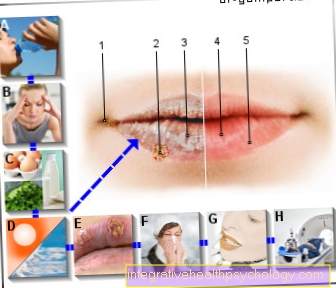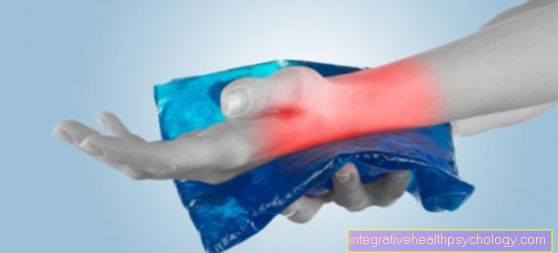Stroke therapy
Synonyms
Therapy apoplexy, ischemic cerebral infarction, cerebral circulatory disorder, apoplectic insult
English:
Stroke, apoplexia

therapy
Of the stroke-Patient must be brought to the clinic immediately and a CT should be performed there as an important diagnostic measure. It is important not to waste time because it applies "Time is brain" (= Time is brain).
To quickly recognize the typical signs, also read our page Signs of stroke.
If there is a vascular occlusion, a so-called lysis therapy to dissolve the thrombus or embolus can only be initiated within three (up to a maximum of 6) hours after the onset of symptoms.
So-called Stroke units are departments in hospitals that specialize in stroke patients. If the condition of the patient and the transport time permit, the patient with Apoplex should be taken to a hospital with a stroke unit in order to ensure optimal care.
The following measures are necessary for a stroke patient:
1. Secure vital functions
Breathing, pulse, blood sugar, blood salts and blood pressure must be continuously monitored and, if necessary, adjusted with medication. The patient receives oxygen when the oxygen saturation of the blood falls below 95%, because an oxygen deficiency state must be avoided at all costs.
2. Prevention of thrombosis
The patient should have an acute Thrombosis prophylaxis preserved for the time of his inability to move so that no complicating factors of the stroke occur. This includes the therapy Heparin, in the following support stockings and movement exercises.
3. The early initiation of blood thinning (anticoagulation) therapy in the event of an ischemic stroke to avoid a recurrence of the stroke
The patient is treated with a platelet aggregation inhibitor, which should prevent the formation of blood clots in the long term. Corresponding drugs are acetylsalicylic acid (aspirin ®) or Clopidogrel ®, which influences the function of receptors.
If the stroke is caused by an embolism, long-term therapy with coumarins (e.g. Marcumar®) can be started.
4. Keep blood pressure at high normal levels
To ensure blood flow to the brain, blood pressure values should be high rather than low. In the first 24 hours after the onset of symptoms, the blood pressure should not be lowered with drugs, unless the values are above 200 to 110 mmHg, in which case a careful blood pressure lowering is necessary.
5. Treatment of increased intracranial pressure
First, the patient is raised in the upper body position to encourage blood outflow from the upper half of the body and the head.
Mannitol, a sugar, can also be given. This binds water and can thus lower the increased intracranial pressure.
Does the lowering with conservative, i.e. non-operative, measures no, neurosurgical intervention can be carried out.
6. Lysis therapy to reopen a closed vessel
Lysis therapy (short: lysis) dissolves a thrombus or embolus in the affected artery. However, this therapy option can only take place within 3 to a maximum of 6 hours after the onset of symptoms, since complications become more and more likely over longer periods of time and ultimately there is no longer any benefit in therapy for the patient.
The most important and at the same time most serious complication of lysis is the occurrence of bleeding: bleeding can occur in the area of the damaged brain tissue, which worsens the prognosis of the patient.
If, on the other hand, the lysis is successful, the patient's symptoms can recede completely, as the cell damage can be reversed by the restored blood flow.
The therapy is carried out with rt-PA; this is an enzyme that dissolves blood clots.
The prerequisites for using this form of therapy are:
- Bleeding is excluded on the basis of the skull CT.
- The therapy takes place in the time window of 3 (at most 6 hours) after the onset of symptoms.
- There is no clouding of consciousness in the patient.
- There are no contraindications / application restrictions for the therapy, such as an already started blood thinning therapy with coumarins, an operation in the last 2 weeks, pregnancy, age over 80 years.
The drug is given by infusion.
7. Early mobilization of the patient and early training
Skills lost as a result of a stroke can be restored through early and intensive exercises and training.
Physiotherapy and, if necessary, speech therapy treatment promotes this restoration of restricted movement and / or speech functions of the patient.
8. Long-term rehabilitation measures
A coordinated and targeted rehabilitation is necessary for the long-term success of the rehabilitation measures in the event of a stroke.
For example, sequences of movements that the patient performs in everyday life are newly learned and trained; in the case of speech disorders, speech training is carried out with the patient; walking is gradually relearned or balance exercises are used when walking unsteadily.
General training to promote muscle strength and muscle suppleness is carried out in order to reduce or avoid spasticity (= muscle cramps) as a result of the apoplexy.
If hemiplegia or paralysis remains, care must be taken that the arm and / or the leg of the affected side is raised so that the lymphatic and blood flow are promoted.
What drugs are used in a stroke?
Few drugs are used in an acute stroke. First of all, an adequate supply of oxygen to the patient should be ensured through an external supply. Is there high blood pressure (hypertension), this should not be treated if it is only slightly increased. This ensures good blood flow to the brain and the affected tissue has the greatest chance of recovering. If the blood pressure is too low (Hypotension) the blood volume should primarily be increased by infusions before drug treatment with catecholamines (Dobutamine, northern renaline) takes place.
If there is brain edema - a swelling of the brain that can squeeze vital areas and cause death - this should be done with so-called osmodiuretics (Mannitol, glycerin, sorbitol) be treated. These compounds are supplied through the vein and remove fluid from the tissue, while they cannot leave the vascular system themselves.
Lysis therapy can be carried out within the first 4.5 hours after the stroke. For this purpose, tissue plasminogen activator (also rt-PA, recombined plasminogen activator or tissue plasminogen activator) is used. The compound splits plasminogen into plasmin and thereby promotes the breakdown of fibrin. Blood clots are made up of fibrin and are responsible for the event in the majority of all strokes. The lysis therapy aims to dissolve the clot in order to restore the blood supply in this way.
You might also be interested in: Stroke measures
Stroke rehab
The time a stroke patient spends in hospital depends largely on the healing process. As soon as the acute clinical symptoms have subsided and a good healing tendency can be recognized, further care can take place in another house. These are usually special rehabilitation centers that specialize in the follow-up and reintegration of neurological patients.
The stay there again depends on the progress of the person concerned, but is usually 4 to 6 weeks. As soon as the basic functions are restored and outpatient therapy is possible, this should also be initiated quickly. Outpatient means that the patient is already staying at home and only visits the care center for certain applications or exercises. Thus, he can find his way back into everyday life better and the family and professional environment is included.
Read more on the topic: What are the chances of recovery after a cerebral hemorrhage?
In order to achieve the best possible results, all departments must work together in neurological rehab. It is well known that a wide variety of functions can be impaired after a stroke - this can lead to paralysis and movement disorders, problems with speaking or other basic body functions. The medical staff must work closely with physiotherapists, occupational therapists and speech therapists (Speech therapists) cooperate to restore the lost skills.
Social workers also have to be involved due to the far-reaching changes in patients' lives. Often not all functions can be regained even through extensive rehab and years of training. Above all, the patient should be trained to live with this circumstance and to be able to help himself. This incision leads to increased depression that must be taken seriously and treated.
Doing exercises in front of the mirror after a stroke
After a stroke, often only one side of the body is particularly badly affected by the impairments. In the majority of all cases, these are expressed as Signs of paralysis. Through remodeling processes in the brain, other areas can take over the functions of the submerged areas. Mirrors can be used to encourage the renovation. This is a complementary therapy method, in which motion sequences through a Delusion of the brain should be trained.
The training takes place in a low-stimulus room, without pictures, screens, windows or other objects that could attract attention. A mirror is placed between the arms lying on a table, for example. This should be large enough to accommodate the healthy or less restricted side of the body do not look at the affected limb to allow. The patient now sees the mirror image of the limb that is well movable.
If targeted movements are now carried out under guidance, the illusion is created that the movement-restricted side of the body is moving healthily. The remodeling process mentioned at the beginning can be accelerated through absolute concentration. The half of the body affected by the stroke will reactivated. The effectiveness of the training varies from person to person, but should always be considered due to its simplicity.
Occupational therapy after a stroke
Inpatient and outpatient therapy for stroke patients is the first step on a long road to recovery, but it is by no means sufficient. Everyone concerned should Initiative grab and perform exercises several times a dayinstead of just taking part in guided activities for a few hours a week. Occupational therapy plays an important role in this and includes performing everyday activities that stroke patients often have to relearn. Daily training has been shown to improve the healing result.
Fine motor skills (or dexterity) is the key to most of everyday movement. To e.g. To train the sense of touch and small movements of the hand, a glass filled with dry legumes can be used. Small figures or objects are put into this. It is the patient's task to feel the objects and thus both his sensitivity, as well as the required ones Movements to train.
This is a normally automated movement Write. Many patients have to relearn how to write after a moderate or severe stroke. However, this learning process paves the way for other movement sequences that are implemented automatically in everyday life - Brushing your teeth, vacuuming, driving a car. The writing training can begin with frequent scribbling on paper and in the course can be transferred to more complex writing exercises. By being motivated to take the initiative, patients are back in life faster and can take part in everyday social and, if necessary, professional life.
Please also read our page about Occupational therapy.
Occupational therapy also plays a major role in a cerebellar infarction. Therefore, also read: Cerebellar infarction
Duration of stroke therapy
The duration of the necessary therapy after a stroke depends on the extent of the damage. The more functional areas go under, the worse the prognosis and the longer the healing process will take. Around half of all stroke patients remain in need of care even after good care. Older patients in particular tend to recover less well from a cerebral infarction.
Staying on a stroke unit (Stroke ward) or in a neurological clinic one to several weeks (usually 2-4 weeks) take advantage of. Usually, a rehab is started afterwards, which again lasts 4 to 6 weeks. The medically supervised healing process takes about 1 to 2 months.
Even after that, the patients must continue to practice the unlearned movement sequences and be monitored on an outpatient basis by their family doctor or a resident neurologist. The duration of the therapy and especially the healing process varies from person to person, but often lasts not just a few months but years.
Also read the article on the topic: Healing after a stroke
How can you prevent a stroke?
General measures
Stroke prevention is the best protection against this condition.
To avoid apoplexy, one should switch off risk factors that cause arteriosclerotic changes in the blood vessels and promote the changes in blood vessels, such as:
- Smoke
- Obesity
- high blood pressure.
Setting blood pressure, blood sugar and LDL cholesterol (consistently keeping LDL cholesterol below 100 mg / dl) to normal values lowers the risk of stroke. Diabetics should aim for optimal blood sugar control and low long-term blood sugar values (= HbA1c values).
Regular exercise with increasing endurance and weight reduction have a positive effect on health and serve to prevent a stroke.
Smoking and alcohol consumption should be avoided.
A balanced, low-fat, vegetable and fruit-rich diet is important.
Read more about this: Prevent a stroke
Medicines to prevent a stroke
Medicinal blood thinning therapy with acetylsalicylic acid or the platelet aggregation inhibitor clopidogrel should be carried out on a long-term basis if the patient has vasoconstriction of the intra- or extracranial vessels. This therapy should also take place if the patient does not (yet) have any symptoms.
The drugs mentioned are also given for so-called secondary prophylaxis after a TIA, PRIND or stroke has occurred, with the aim of preventing another stroke from occurring.
Patients who have chronic atrial fibrillation or who have suffered a stroke as a result of an embolism should also receive blood-thinning therapy. This can be done with Marcumar or heparin.
Please also read our topic: Aggrenox
Surgical interventions for the prophylaxis of a stroke
Surgery to reopen the narrowed / occluded internal carotid artery is indicated if the patient has symptoms of a stroke and the vessel is over 70% occluded or if there are no symptoms but the vessel is over 80% occluded.
Patients who are symptom-free but have a severe vascular narrowing (= vascular stenosis) should have an operation, as there is a 10% risk for them of suffering a stroke within three years.
Is there a so-called aneurysm? before, that means a bulging of a vessel, a stroke can be prevented by switching off the aneurysm and thus preventing a rupture and subsequent cerebral hemorrhage.
Read more on this topic: Cerebral artery aneurysm
What drugs are given to prevent after a stroke?
In order to prevent a first-time stroke, medication is used for so-called primary prevention. Here, the disease event should be caused by the Treatment of risky underlying diseases be prevented. The drugs are drugs against to high blood sugar and blood pressure, against Arrhythmias (Antiarrythmics), around Blood thinner for clots (Anticoagulants) and around Lipid lowering drugs (Statins).
Even after a stroke, the drugs that are used to prevent recurrence (Avoiding a recurrence of the stroke) are used, the same. If a vascular occlusion was the cause of the infarction (ischemic infarction), becomes standard ASS 100 prescribed. Also known as Aspirin®, this medicine works by reducing the build-up of blood platelets (Antiplatelet drugs) and thus inhibits blood clotting.
If ASA is not tolerated, so can Clopidogrel (also a platelet aggregation inhibitor) or another drug from the drug group (Prasugrel, ticagrelor) are used.
Statins are also used in relapse prevention, for example Simvastatin given when the blood cholesterol is too high. Values that are too high can lead to fatty tissue and the resulting calcification of the vessels, which can then lead to repeated occlusions.
The blood pressure should be in the target range between 120/70 and 140/90 mmHG can be set. Come to this ACE inhibitors (e.g. Ramipril), Calcium channel blockers (e.g. Amlodipine), Beta blockers (e.g. Metoprolol) and many other drugs are used.
Is used as part of the cause diagnosis Atrial fibrillation of the heart detected must have a blood thinning Coumarin derivatives (Marcumar® or Falithrom®) or with new anticoagulants like Dabigatran (Pradaxa®) respectively.
Summary
Signs of a stroke should be diagnosed as such as soon as possible and the cause of the stroke treated. This is particularly critical for the success of the therapy quick diagnosis and the beginning of therapeutic measures. By the Restoring the oxygen supply In the affected parts of the brain, the signs and symptoms of the stroke usually recede. If the inadequate supply persists over a long period of time, brain tissue perishes and the symptoms that initially appeared as signs of the stroke may persist for life. A Bleeding should, if possible, for Standstill be brought while clogging the vessel dissolved can be.
In order to prevent the occurrence of a stroke and thus the signs should the Risk factors for the development of the disease to be minimized. So should he Blood pressure checked and hypertension are treated. Cardiac arrhythmias should also be treated to prevent blood vessel clogging.
A healthy lifestyle and thus renouncing nicotine and excessive enjoyment of alcohol and a healthy diet can also help significantly reduce the risk of stroke in the course of life.





























